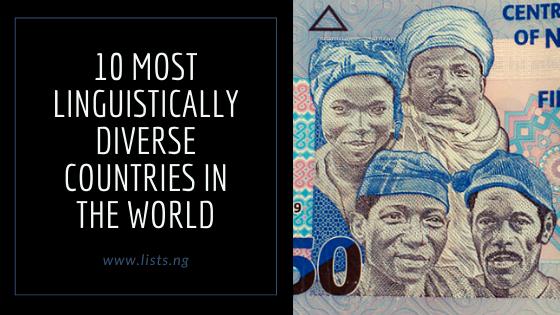Languages are important in our lives, not only because it allows us to communicate and share common ideas, but it is also essential to culture and identity. Languages are a means of expressing and preserving values, beliefs and customs within a group and across other groups.
There are around 6,500 different languages in the world and every country possess their diverse linguistic make up. Ethnically diverse countries like Nigeria have as much as 500 different languages.
Below are the top ten countries that speak the most languages.
1. Papua New Guinea – 851
Papua New Guinea, an island country in the southwestern Pacific Ocean. Having been ruled by three external powers since 1884, Papua New Guinea established its sovereignty in 1975, becoming an independent Commonwealth realm in 1975 with Elizabeth II as its queen. Although one of the world’s least explored territories, Papua New Guinea is regarded as one of the most culturally diverse countries in the world. It has a population of 8 million people with 851 languages, of which 11 now have no known speakers.
2. Indonesia – 700+
Indonesia, officially the Republic of Indonesia, is a country in Southeast Asia and Oceania, between the Indian and Pacific oceans. Indonesia is the world’s largest island country and the 4th most populous country with 261 million people. Indonesia is the second most linguistically diverse nation with over 700 languages spoken by its people. Javanese is both the largest ethnic group in the country and the largest language by the number of native speakers, constituting 40.2% of the population.
3. Nigeria – 521
Nigeria, an African country on the Gulf of Guinea, known for its diverse culture. There are more than 250 ethnic groups with over 500 distinct languages all identifying with a wide variety of cultures. The three largest ethnic groups are the Hausa–Fulani in the north, Yoruba in the west, and Igbo in the east; comprising over 60% of the total population.
4. India – 450+
India is the second-most populous country, the seventh-largest country by area, and the most populous democracy in the world. India is home to two major language families: Indo-Aryan (spoken by about 74% of the population) and Dravidian (spoken by 24% of the population). India has no national language, however, Hindi has the largest number of speakers and is the official language of the government. Although the constitution recognises in particular 22 “scheduled languages”, India has over 400 languages.
5. United States of America – 430
The United States is a federal republic of 50 states located in North America. Although the United States does not have an official language, the most commonly used language is English (specifically, American English), which is the de facto national language. Around 430 languages are spoken or signed by the population, of which 176 are indigenous to the area.
6. China – 301
The People’s Republic of China is the world’s most populous country, with a population of around 1.4 billion in 2019 and an area covering approximately 9.6 million square kilometres.There are as many as 300 languages in China.The languages most commonly spoken belong to the Sinitic branch of the Sino-Tibetan language family, which contains Mandarin (spoken by 70% of the population), and other varieties of Chinese language: Yue (including Cantonese and Taishanese), Wu (including Shanghainese and Suzhounese), Min (including Fuzhounese, Hokkien and Teochew), Xiang, Gan and Hakka.
7. Mexico – 364
Mexico is a country in the southern portion of North America famously bordered by the United States. Spanish is the de facto national language spoken by the vast majority of 1128 million population, but the federal government officially recognizes sixty-eight linguistic groups and 364 varieties of indigenous languages.
8. Cameroon – 250+
République du Cameroun is a country in Central Africa. It is bordered by Nigeria to the west and north; Chad to the northeast; the Central African Republic to the east; and Equatorial Guinea, Gabon and the Republic of the Congo to the south. English and French are regarded as its official languages, but Cameroon is home to over 250 native languages spoken by nearly 20 million people.
9. Australia – 250
Australia is a sovereign country comprising the mainland of the Australian continent, the island of Tasmania, and numerous smaller islands. It is the largest country in Oceania and the world’s sixth-largest country by total area. Although Australia has no official language, English is the de facto national language.There are over 250 Indigenous Australian languages and about 110 are spoken exclusively by older people.
10. Brazil – 228
Brazil is the largest country in both South America and Latin America with an area 8.5 million square kilometres and a population of 211 million people. The official language of Brazil is Portuguese, which almost all of the population speaks and is virtually the only language used in newspapers, radio, television, and for business and administrative purposes. As of 2019, the population of Brazil speaks or signs approximately 228 languages, of which 217 are indigenous and 11 came with immigrants






